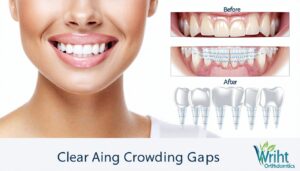Understanding Braces and Aligners
In the quest to obtain a beautiful smile, braces and aligners have emerged as two popular orthodontic appliances. These tools help reposition teeth to improve oral health and aesthetics.
Orthodontic Treatment Overview
Orthodontic treatment involves correcting teeth and jaw alignments. This process is usually carried out with appliances like braces or aligners. They apply gentle pressure over time to move teeth into the desired position. The choice of appliance often depends on the patient’s preference and the complexity of their orthodontic issues.
Differences Between Braces and Clear Aligners
While both braces and clear aligners serve the same purpose of aligning teeth, they differ significantly in their design, application, and user experience.
| Feature | Braces | Clear Aligners |
|---|---|---|
| Appearance | Metal or ceramic brackets attached to the front of each tooth, connected by wires and elastic bands | Clear, virtually invisible trays that fit over the teeth |
| Removability | Fixed and can only be removed by a dentist or orthodontist | Removable for eating, drinking, brushing, and flossing |
| Adjustment | Adjustments made by a dentist or orthodontist during regular visits | Progresses through a series of custom-made trays, each slightly straighter than the previous |
| Comfort | Can cause discomfort due to wires and brackets | Smooth plastic trays are generally more comfortable |
Traditional braces involve metal or ceramic brackets glued to the teeth, connected by wires. The orthodontist adjusts these wires periodically to shift the teeth gradually. They are highly effective for complex cases but are noticeable and can sometimes cause discomfort.
On the other hand, clear aligners are virtually invisible, custom-made trays that fit snugly over the teeth. They are removable, allowing for easier eating and cleaning. They are a popular choice for adults and teenagers seeking a more discreet form of treatment. However, they may not be suitable for more complex orthodontic issues.
Understanding these differences is crucial when considering orthodontic treatment. Each option has its own set of benefits and drawbacks, and the best choice will depend on the individual’s specific circumstances and goals. Whether one opts for braces or clear aligners, the end result is the same: a healthier, more beautiful smile.
Benefits of Clear Aligners
As part of the journey to a beautiful smile, many people choose clear aligners over traditional braces. The reasons are numerous, but the key benefits of clear aligners lie in their enhanced aesthetics, comfort, convenience, and the advantages they offer in terms of oral hygiene.
Enhanced Aesthetics
One of the primary benefits of clear aligners is their aesthetic appeal. Unlike traditional braces, which use metal brackets and wires that are easily visible, clear aligners are virtually invisible. They are made from a clear plastic material that fits precisely over the teeth, making them a discreet option for orthodontic treatment. This means that one can undergo treatment without feeling self-conscious about their appearance – a significant advantage for adults and teenagers.
Comfort and Convenience
When it comes to comfort and convenience, clear aligners outshine traditional braces. The aligners are custom-made for each individual, meaning they fit snugly and comfortably over the teeth. There are no metal brackets or wires to rub against the inside of the mouth, reducing the risk of sores or injuries.
Moreover, clear aligners can be removed for eating and drinking, eliminating the need for dietary changes often required with traditional braces. There’s no need to worry about food getting stuck in brackets or wires, making meal times a more enjoyable experience.
Removability and Oral Hygiene
The removability of clear aligners also provides significant benefits when it comes to oral hygiene. Unlike braces, which can make brushing and flossing a challenge, clear aligners can be taken out for regular cleaning. This allows for a thorough brushing and flossing regimen, reducing the risk of issues like tooth decay and gum disease during treatment.
In addition, the aligners themselves can be cleaned separately, providing an additional level of oral hygiene that isn’t possible with traditional braces. It’s important to clean the aligners regularly to keep them clear and free from bacteria.
In summary, the benefits of clear aligners extend beyond just aesthetic appeal. Their design offers a level of comfort and convenience that is hard to match, while their removability allows for superior oral hygiene during treatment. These factors make clear aligners a popular choice for those seeking a discreet, comfortable, and convenient route to a beautiful smile.
Effectiveness of Clear Aligners
One of the main factors to consider when choosing an orthodontic treatment is its effectiveness. In this regard, clear aligners have shown promising results in correcting various alignment issues and providing efficient treatment duration.
Correcting Alignment Issues
Clear aligners are designed to correct numerous alignment issues, including overcrowding, gaps between teeth, overbites, underbites, and crossbites. They work by applying consistent pressure on the teeth, gradually moving them into the desired position.
The effectiveness of clear aligners in correcting these alignment issues depends on various factors, like the severity of the condition, the patient’s age, and their compliance with the treatment plan. For example, clear aligners are typically more effective in treating mild to moderate alignment issues. More severe cases may require additional orthodontic procedures or appliances for optimal results.
Despite these considerations, the benefits of clear aligners make them an appealing option for many individuals seeking to improve their smile.
Treatment Duration
The duration of treatment with clear aligners varies depending on the complexity of the case. However, on average, clear aligner treatment can range from 6 to 18 months. This is often shorter than the treatment duration for traditional braces, which can take 18 to 24 months or longer.
It’s important to note that the success of clear aligner treatment largely depends on the patient’s commitment to wearing the aligners for the recommended 20 to 22 hours per day. Failure to adhere to this guideline can prolong the treatment duration and affect the final results.
| Treatment Type | Average Duration |
|---|---|
| Clear Aligners | 6 – 18 months |
| Traditional Braces | 18 – 24 months |
In conclusion, clear aligners offer an effective and efficient solution for correcting various alignment issues. Before choosing this treatment, individuals should consult with an orthodontist to discuss their specific case and determine if clear aligners are the most suitable option for them. With proper use and care, clear aligners can help achieve a beautiful, straight smile in a relatively short period.
Considerations Before Choosing
While clear aligners offer several positives, before making a decision, it’s important to consider factors such as cost and suitability for individual cases.
Cost Comparison
When it comes to orthodontic treatment, cost is often a major factor in decision-making. Traditional braces and clear aligners vary in price, with the cost of treatment depending on factors such as the complexity of the case, length of treatment, and the specific provider.
It’s also worth noting that many orthodontic practices offer payment plans to make the treatment more affordable. Some dental insurance plans may also cover a portion of the cost.
Suitability for Different Cases
While clear aligners have proven effective in treating a variety of orthodontic issues, they may not be suitable for all cases. Clear aligners are often a good choice for correcting mild to moderate issues, such as crowding, spacing, and some bite issues.
More complex cases, such as severe crowding, significant overbites or underbites, or cases requiring the movement of molars, may be better suited to traditional braces.
Moreover, clear aligners require a high level of patient compliance, as they must be worn 20-22 hours per day for the best results. Individuals who cannot commit to this level of wear may achieve better results with fixed braces.
In summary, while there are numerous benefits of clear aligners, these factors should be considered. Prospective patients should consult with an orthodontist to discuss the best treatment option for their individual needs and circumstances.
Maintenance and Care
Proper maintenance and care are essential to maximize the benefits of clear aligners and to ensure a successful treatment outcome. This involves regular cleaning of the aligners and consistent follow-up appointments with the orthodontist.
Cleaning Clear Aligners
Clear aligners need to be cleaned regularly to maintain their clarity and to prevent buildup of bacteria. Unlike traditional braces, which can be difficult to clean around, clear aligners can be removed for effective and thorough cleaning.
Here is a simple cleaning routine for clear aligners:
- Remove the Aligners: Always take out the aligners before cleaning.
- Rinse: Rinse the aligners under lukewarm water. Avoid hot water as it can warp the plastic.
- Clean with a Soft Brush: Use a soft toothbrush with a small amount of non-abrasive toothpaste or soap to gently brush the aligners. Brush both the inside and outside surfaces.
- Rinse Again: After brushing, rinse the aligners thoroughly under lukewarm water.
- Let it Dry: Let the aligners air dry before putting them back in the mouth.
- Clean Your Mouth: Before putting the aligners back in, ensure your mouth is clean to avoid trapping food particles or bacteria.
It’s recommended to clean the aligners at least once a day. Avoid using colored or scented soap as it can stain or leave a residual taste.
Follow-Up Appointments
Regular follow-up appointments with the orthodontist are another crucial aspect of clear aligner care. These check-ups allow the orthodontist to monitor the progress of the treatment and make any necessary adjustments.
Initial appointments might be more frequent, usually every 2-3 weeks, as the orthodontist assesses the fit of the aligners and the movement of the teeth. As the treatment progresses, the frequency of the appointments might reduce to once every 4-6 weeks.
During these appointments, the orthodontist will provide the next set of aligners in the treatment plan. It’s essential to wear each set of aligners for the recommended period, typically around 2 weeks, before moving on to the next set.
Proper maintenance and consistent follow-up appointments are key to achieving the best results with clear aligners. With the right care, clear aligners can offer a convenient and effective solution for achieving a beautiful smile.
Final Results
After going through the journey of orthodontic treatment with clear aligners, the final results can be thrilling. This section will discuss the smile transformation and the retention phase that follows the completion of treatment.
Smile Transformation
The ultimate goal of using clear aligners is to achieve a more aesthetically pleasing and functional smile. With the completion of the treatment, one can expect to see significant changes in the alignment and spacing of their teeth.
The final smile transformation can have profound effects on a person’s confidence and self-esteem. With straighter teeth, individuals often find themselves smiling more, enhancing their overall facial aesthetics and contributing to a more positive self-image.
In addition to the cosmetic benefits, clear aligners can also improve oral function. Correct alignment allows for better chewing efficiency and can help alleviate issues related to TMJ (temporomandibular joint) disorder.
Retention Phase
Following the smile transformation achieved with clear aligners, it’s essential to move into the retention phase to maintain the newly straightened teeth. This phase involves the use of a retainer, a device designed to hold the teeth in their new positions until the bones and gums adapt to the changes.
Retainers can be removable or fixed, and the type used often depends on the individual’s specific circumstances and the recommendation of their orthodontist. Removable retainers offer the convenience of being able to take the device out for eating and oral hygiene practices. In contrast, fixed retainers, usually bonded to the back of the teeth, provide the assurance that the retainer is always working to maintain the alignment.
The duration of the retention phase can vary from person to person. Some individuals may need to wear their retainers full-time for a couple of months, while others may only need to wear them at night. In many cases, orthodontists recommend long-term use of retainers to ensure the stability of the treatment results.
To reap the benefits of clear aligners fully, it’s crucial to adhere to the instructions provided by the orthodontist during the retention phase. Regular follow-ups, proper oral hygiene, and consistent use of retainers can help to maintain the beautiful smile achieved with clear aligners.






